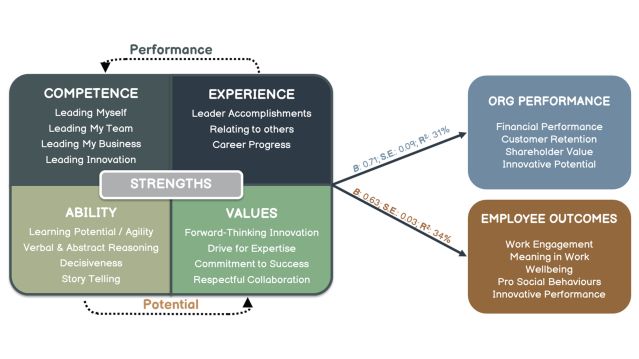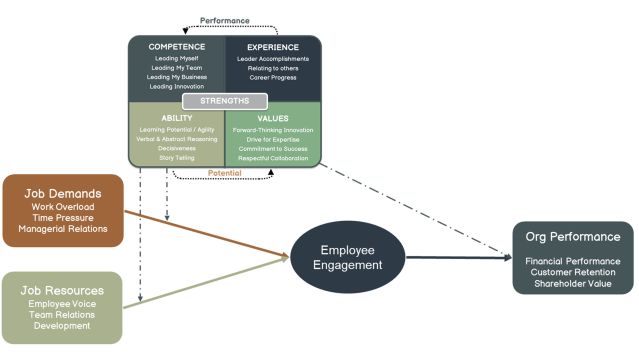Leadership
Data-Driven Leadership Development
How to harness data to build leadership development interventions that work.
Posted May 31, 2024 Reviewed by Davia Sills
Key points
- Data-driven leadership development uses advanced analytics to create targeted, personalized interventions.
- Develop a validated leadership capability model to identify the core capacities predicting performance.
- Build a roadmap that links job characteristics and individual capabilities to hard performance metrics.
- Create hyper-personalized development plans to address specific leadership needs.
Leadership is the cornerstone of organizational success, with research showing that about 70 percent of the variance in employee engagement is attributable to the quality of leadership. Effective leadership can stave off high turnover rates and mitigate the negative impacts of significant organizational changes on motivation and performance. Yet, despite the importance of leadership, many organizations still rely on intuition rather than empirical evidence to guide their leadership development strategies. This reliance on gut feeling undermines the effectiveness of leadership initiatives and hampers overall organizational performance.
The Problem With Traditional Leadership Development
Organizations invest billions of dollars annually in leadership development initiatives, yet many fail to link the leadership behaviors they aim to develop with core performance metrics. Traditional approaches often involve generic, one-size-fits-all programs that yield minimal financial returns. These programs fail to show the true impact of leadership development on organizational success, leaving leaders unprepared for the unique challenges they face.
However, this status quo is not unchangeable. By embracing a data-driven approach, organizations can bridge the gap between leadership behaviors and performance metrics, unlocking new pathways to success. One way is through data-driven leadership development interventions. Data-driven leadership development uses real-time data and advanced analytics to identify the specific leadership capabilities that predict performance and then develop these through hyper-personalized interventions.
What Is Data-Driven Leadership Development?
Data-driven leadership development involves leveraging empirical data to inform your leadership assessment and development strategies. This approach identifies the core competencies, behaviors, abilities, and mindsets that predict organizational success. It allows organizations to make informed decisions about their developmental interventions based on objective reality rather than subjective opinions.
Moreover, data-driven approaches provide real-time intelligence on skills availability and performance drivers, helping organizations anticipate future leadership needs. By aligning leadership development with organizational goals, companies can create hyper-personalized learning journeys tailored to individual and organizational needs.
The Transformative Potential of Data-Driven Approaches
Data-driven leadership development is not just a shift in strategy; it represents a paradigmatic evolution in talent management. Here are some key benefits:
- Informed Decision-Making: Data provides a roadmap for leadership development, allowing organizations to focus on behaviors and competencies that directly impact performance.
- Personalized Interventions: By understanding the unique strengths and weaknesses of leaders, organizations can design targeted development plans that maximize impact.
- Future-Proofing Leadership: Data helps organizations anticipate and address future leadership needs, ensuring they have the right talent to navigate upcoming challenges.
- Continuous Improvement: Real-time feedback on leadership initiatives facilitates continuous evaluation and refinement, ensuring development efforts remain agile and responsive.
- Maximized ROI: Data-driven approaches ensure resources are allocated effectively, enhancing the return on investment in leadership development.
Three Steps to Implementing Data-Driven Leadership Development
At its core, data-driven leadership development involves three critical steps
1. Develop and Validate a Data-Driven Leadership Capability Model: The first step involves understanding what constitutes excellent leadership within your organization. Construct a leadership capability profile using data from diverse sources to outline the key competencies, experiences, abilities, and values required for effective leadership. This profile should be aligned with organizational goals and validated through empirical data.

2. Build a Data-Driven Leadership Development Roadmap: Construct a predictive process model linking individual capabilities to performance metrics. This involves measuring job demands, resources, motivational factors, and key performance indicators within the organization. Assess leaders against the capability profile and analyze how these factors influence performance. This model will help identify the exact leadership capabilities to develop first to improve performance.

3. Develop Hyper-Personalized Leadership Development Interventions: Use the insights from the capability model and the roadmap to create personalized development plans for each leader. These plans should address specific areas for improvement and align with organizational goals. Incorporate a variety of learning resources and methods to cater to different learning styles and ensure ongoing evaluation and feedback to continuously refine the development process.
Conclusion
Embracing data-driven leadership development is a crucial step for organizations aiming to enhance their performance and stay competitive. By constructing empirically validated leadership capability models and integrating these insights with theoretical frameworks, companies can design hyper-personalized development plans with real-world impact.
Organizations must take action to adopt data-driven approaches, ensuring their leadership development efforts are not only effective but also aligned with their strategic objectives. This shift will unlock the full potential of their leadership talent, driving sustained organizational success.
The call to action is clear: It's time to move away from intuition-based leadership development and embrace a data-driven approach. Doing so will not only improve leadership quality but also significantly enhance organizational performance and resilience in the face of future challenges.
References
Stander, E., & Van Zyl, L.E. (2019). The Talent Development Centre (TDC) as an integrated positive psychological leadership development and talent analytics framework. In L.E. van Zyl & S. Rothmann (Eds.), Positive Psychological Intervention Design and Protocols for Multi-cultural Contexts. Cham, Switzerland: Springer.
Van Zyl, L. E., Dik, B. J., Donaldson, S. I., Klibert, J. J., Di Blasi, Z., Van Wingerden, J., & Salanova, M. (2024). Positive organisational psychology 2.0: Embracing the technological revolution. The Journal of Positive Psychology, 19(4), 699-711.
Hughes, A. (2021). Leadership Development Programs: A Comparative Analysis of Indian and Canadian Organizations. International Journal of Transcontinental Discoveries, ISSN: 3006-628X, 8(1), 21-27.




